By Andrea Zachrich
My first impression of the Coliseum was that it was smaller than the Rosebowl. My second thought after that was that the Rosebowl was unlikely to still be standing 2,000 years from now in the same way the Coliseum is. My third thought was awe at the fact that this incredibly large structure has withstood the test of time (not without damage, of course, but what’s left is still pretty spectacular).
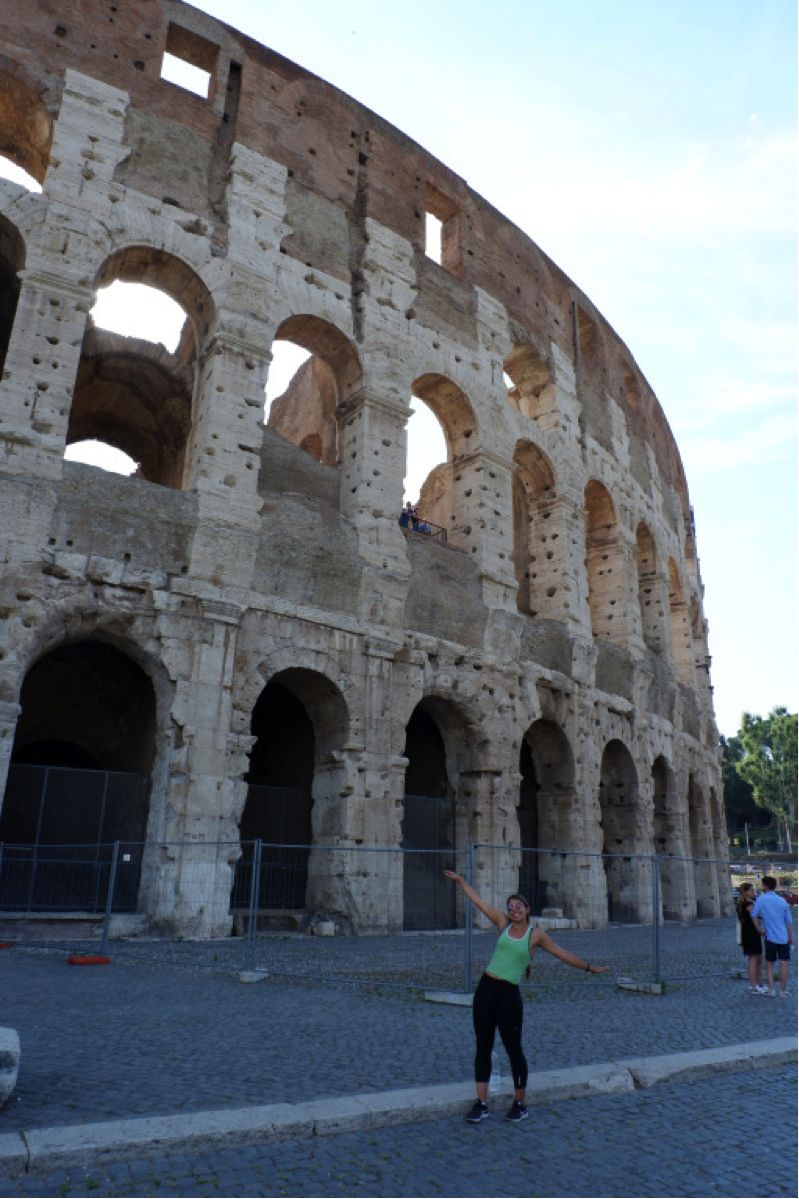
The Facts
Its Name
I love the story of how the Coliseum got its name. During the reign of Emperor Nero, he commissioned a massive bronze statue of himself as the sun god that was often called the “colossus” because of its huge size. (It was one of the seven wonders of the ancient world). This statue, which was nearly 100 feet tall, stood right next to the coliseum (with various reworkings of the face for different emperors) until an earthquake in 1000 toppled it, but by then the name of the amphitheater had already been determined. So the name Coliseum comes from the word colossus and essentially refers to a structure that is near the colossus statue of Nero. The true name of the amphitheater is Amphitheatrum Flavium in latin, or Flavian Amphitheater in English, because it was constructed during the Flavian dynasty. That name, however, is rarely used, and the word coliseum with a lowercase “c” has even come to be used for other amphitheaters from the Roman world.
Ancient History
The Coliseum was started around 72 AD by Emperor Vespasian, and was completed by his son Emperor Titus in 80 AD following Vespasian’s death. The name Flavian Amphitheater comes from these emperors, who were a part of the Flavian dynasty. It was paid for by using wealth acquired from booty during war. According to ancient sources, the inaugural games of the Coliseum lasted a full month, and 9,000 animals were killed and there were hundreds of gladiatorial fights and other spectacles. Some scholars even believe that the amphitheater may have even been filled with water and used for mock naval battles, but other scholars believe that this may have only happened once at the inaugural games or not at all (the Romans did have these mock naval battles, called naumachia, but the location usually made use of existing bodies of water and thus the Romans may not have needed/wanted to use the Coliseum for this purpose). It could seat around 50,000-80,000 people depending on the amount of wooden seating at the top and how packed in the people were. The structure has a series of underground tunnels (you can see them today because the wooden floor no longer exists) that would be used to raise wild animals into the arena or sometimes gladiators from special trapdoors. It also had a canvas cover on the top of the amphitheater called the vela or velarium, the latin word for sail (like from a sail boat) that served to protect viewers from the sun or rain. All of the games at the Coliseum were free to attend and were usually paid for by the emperor, but you had to secure a token with a seat on it prior to the event in order to be allowed in. But, if you were an elite, you didn’t need this token. The emperor had his own box, the senators had marble seats (you can still see this section of seating today), and many elite families had their own boxes in the Coliseum from which to watch the games.
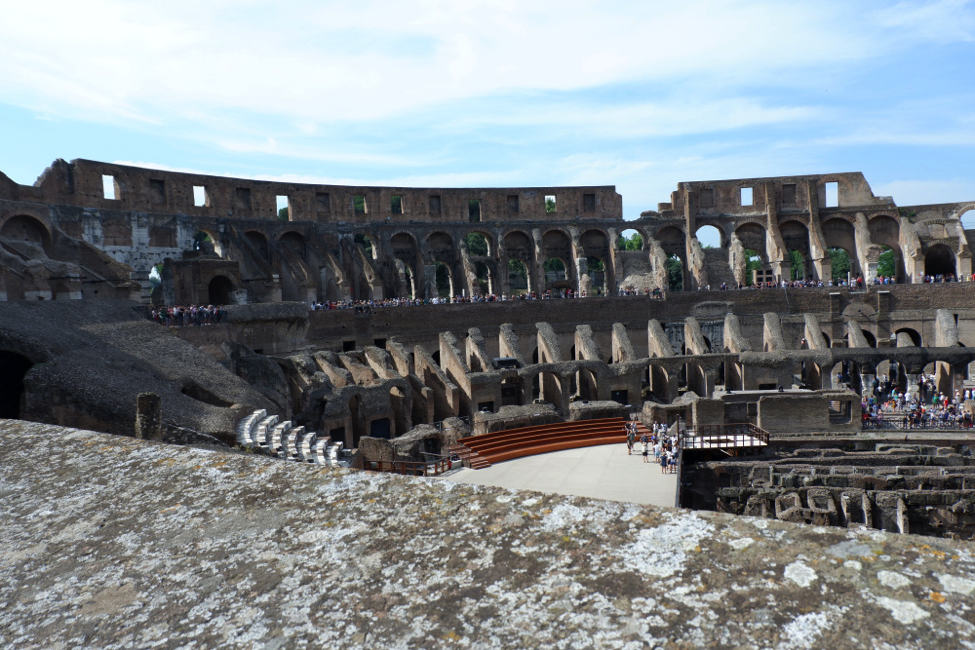
Materials and Architecture
The Coliseum is really a remarkable structure, and has stood for nearly 2,000 years with minimal damage aside from deliberate material robbing. The Coliseum is the largest amphitheater from antiquity. It is mainly made of concrete, tufa (a volcanic stone common in Roman building), and travertine (another stone commonly used by the Romans). It was faced with marble and had statues facing outwards in all of the archways in antiquity. It has three stone layers of seatings (with ionic, doric, and corinthian capitals on the outside) and used to have a top, wooden layer of seating that was the Roman equivalent of the nosebleed seats which most likely burnt down. These wooden seats required near constant maintenance in antiquity, and were frequently subjected to fires and other damages that come from being outside. The structure had a central wooden platform (now completely gone – probably because it rotted away over time) that would have been covered with sand where all the spectacles took place. As discussed earlier, there is an extensive system of tunnels under this floor that were used to place animals and people into the arena. Below are some photos that show the series of tunnels under the floor.
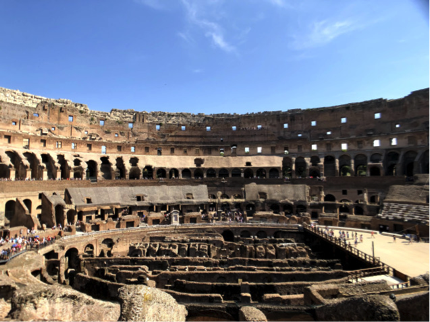
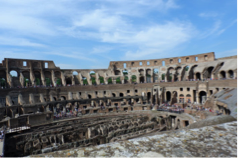
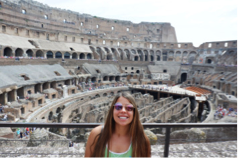
Modern History
During the early medieval ages, the arches of the Coliseum housed shops and were used as housing. There was also a chapel built in the structure at this time. Around 1200 AD, the Frangipani family took over the entire Coliseum and used it as a fort and to house their family. In the mid 1300’s, an earthquake toppled much of one of the sides, and the stones that fell were reused in other buildings around Rome. Similar to many other buildings in Rome, the bronze clamps that held the stone together were actually dug out of the stone, and you can still see the holes that this left on the structure today (and makes it even more remarkable that the Coliseum is still standing). In the mid 1700’s, Pope Benedict XIV declared the site to be sacred and forbid further quarrying because he claimed that Christians had been martyred in the structure. While the Roman did prosecute Christians for much of their history, there is no historical evidence that executions took place in the Coliseum, and many scholars believe that no Christians were ever killed there for the crime of being Christian. There is, however, still a large cross inside of the Coliseum, and this Pope’s declaration did help save the amphitheater from further damage. The Coliseum was finally fully excavated under Mussolini, and underwent a massive restoration project from 1993-2000. There used to be a ton of cats that lived in the Coliseum, but there aren’t as many today. I saw one when we went as a class, and none when I went with my brother. Today, it is one of the most popular tourist attractions in Italy, and draws in massive amounts of revenue for the Italian government.

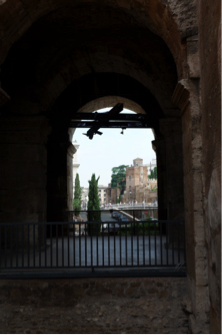

Random fun fact: gattara is the Italian word for an old lady who takes care of cats on the streets, and its one of my favorite words I learned in Italian (along with cucchioli which means puppies or kittens which I learned when visiting my Sicilian family and their puppy!) Writing about the stray cats in the Coliseum reminded me about this word.

The Gladiators
Now we get to the good part: the gladiators of the Coliseum. Contrary to popular belief, only about 10 percent of gladiators ever died in battle or from their wounds in battle. It was still a very risky profession, but not as dramatic as is often depicted in movies. Gladiators often did not battle to the death because a gladiator is an expensive investment for their ludus, or gladiator school, because they must be trained, housed, and clothed. It would not be economical to own gladiators if your investments die half the time they were used for a fight. Most gladiators were slaves, although some people did choose to be gladiators. They occupied an interesting place in society. Many were wealthy, as they often got paid large sums to fight, and good gladiators had a type of celebrity status in Rome, but they also were denied the right to citizenship, and many were slaves (although they could often afford to pay for their freedom with their battle fees). They could not marry Roman citizens (although there are stories of particularly famous gladiators consorting with senator’s wives), and had tattoos to signify that they were gladiators. The fame and wealth accompanied with the loss of rights meant that gladiators occupied this strange limbo ground in Roman society.
Going There
Honestly, getting into the Coliseum is really quite a process. As with most tourist attractions in Rome, I would recommend going early and maybe even getting in line before they open. I would also get tickets in advance, or get the super ticket from the Forum the day before so that you don’t have to wait in line to buy a ticket here. When we went as a class, we got there quite early, maybe around 8:30 and only had to wait in line about 30 minutes. My brother and I went a different time and got there around 9:30, and had to wait in line for a little over an hour before we even got to buy our tickets. It takes so long because they send you through security (of which they should have more open) and then have you purchase your ticket after, which, as you can imagine, is a slow moving process. The price of the ticket isn’t terrible, i believe its only 15 euros to visit both the Coliseum and the Roman Forum.
I really enjoy learning about the Coliseum. It is an iconic symbol of Rome, and reminder of the wacky types of entertainment the ancient Romand enjoyed. It’s name, history, construction, and the gladiators that fought (and died) here are all fascinating, and learning about them really enhanced my visit to this awesome place. It was even cooler to take my brother back a second time and teach him all of things that I had learned. In many ways, the Coliseum is symbolic of the ancient Romans: its massive and beautiful and opulent with a violent and bloody history.






